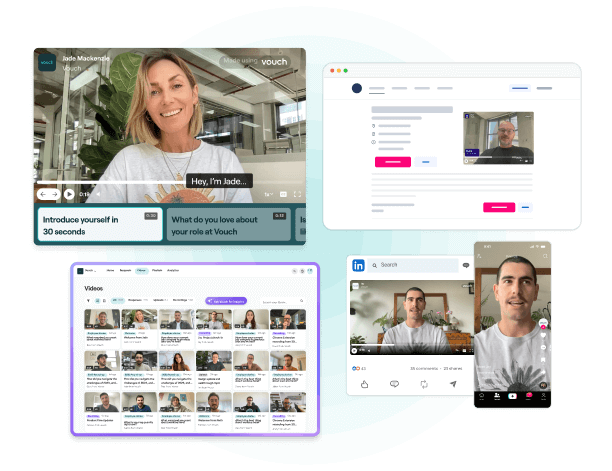The HR to Employee Ratio is an important metric for companies, regardless of your businesses size - there needs to be the right ratio.
But how many hr people per employee do you need?
This "ratio" is key to know, as it offers a clear view into how much help and resources HR gives for handling employees, and knowing the resources you need as your company grows.
This is also where modern software tools like Vouch video can help, as they can help reduce the load on HR teams when it comes to recruitment, including interviews and onboarding.
Let's get started:
Key Takeaways:
- A proper ratio allows HR to allocate ample time and resources for training, recruitment, employee relations, and compliance.
- Larger companies usually have a higher ratio than smaller companies.
- The ideal HR to Employee Ratio varies based on company size, industry, and of course budget.
- Modern software tools like Vouch can help you reduce the workload of your HR people and talent acquisition teams.
What Is The Importance of Your Human Resources to Employee Ratio?
The HR to Employee Ratio ensures your HR pros have enough time for important tasks, including training programs that help employees grow.
Keeping a good HR to Employee Ratio helps with smooth hiring, fair pay, and safe work conditions.
Of course, the fewer employees each HR manager has, the more time your HR managers can spend on employee relations and building a workplace culture that attracts the very best talent in the first place.
Your HR-to-employee ratio is always delicate and it's best to listen to your HR managers and keep a close eye on their workloads.
Bring your employer brand to life
- Empower employees’ storytelling
- Transform careers sites with video
- AI-driven video editing
- Publish videos anywhere

How Do You Calculate The HR to Employee Ratio?
The HR to Employee Ratio is crucial for assessing if there's enough HR support.
To calculate this ratio, divide the total HR staff by the total employees.
The formula is simple:
HR to Employee Ratio = Number of HR staff / Number of employees.
This ratio can be shown as a percent, decimal, or staff per hundred or thousand workers. How you choose to show it depends on your company's needs.
Evaluating the HR to Employee Ratio helps HR teams understand how many hours each HR person has per employee. Monitoring this ratio offers valuable information on HR effectiveness and resource use. It also lets organizations adjust HR staff numbers as business needs change.
What Are 5 Human Resources to Employee Ratio Strategies?
1. Benchmark by Industry and Company Size
Different industries have vastly different needs when it comes to HR support. For example:
- Tech startups might get by with a 1:100 ratio early on, especially in companies with an amazing employer brand and company culture.
- Manufacturing firms with heavy compliance may need a 1:50 or better.
- Healthcare and education sectors often require lower ratios due to regulatory and staffing complexities.
👉 Tip: Regularly compare your ratio against industry standards using SHRM or local HR benchmarks to ensure competitiveness.
2. Scale HR Capacity with Business Growth
Don’t wait until pain points emerge before scaling HR, as your company culture could suffer.
As headcount grows, demands on HR increase in complexity - covering recruitment, employee relations, training, and compliance.
👉 Tip: Plan for HR growth at milestone thresholds (e.g., 50, 100, 250 employees). Add specialized roles (e.g., HRBP, recruiter, payroll) rather than generalists when scaling.
3. Leverage HR Technology to Boost Efficiency
Implementing HR software (e.g., BambooHR, Gusto, or Workday) can significantly reduce administrative burdens, enabling a leaner HR team to manage more employees effectively. You can also use tools like Vouch to improve your internal communications, which can be a major driver of lower HR to Employee rations.
👉 Tip: Invest in systems that automate onboarding, benefits administration, time tracking, and performance reviews to reduce manual workload.
4. Assess HR Workload Regularly
Ratios alone can be misleading. A 1:75 ratio might work if employee needs are low, but become insufficient during periods of high turnover or organizational change.
👉 Tip: Conduct quarterly reviews of HR responsibilities and employee satisfaction to determine whether HR resources are stretched too thin.
5. Use a Hybrid Model for Specialized Functions
Not all HR tasks require a full-time, in-house team.
Consider outsourcing specialized functions like legal compliance, payroll, or recruiting during peak hiring seasons.
👉 Tip: Use external partners to manage overflow or niche areas while maintaining core HR in-house to retain culture and consistency.
Which Companies Can You Look To For HR Inspiration?
Several organizations are renowned for having exemplary Human Resources (HR) teams, recognized for their innovation, employee engagement, and strategic HR practices. These recognitions come from reputable industry rankings and employee feedback platforms.
🌟 Top Companies with Outstanding HR Teams
1. Encora
Encora, a global next-gen product engineering provider, was named the #1 HR Team globally in Comparably's 2023 awards. This recognition was based on employee feedback across nearly 20 workplace culture categories, including leadership, professional development opportunities, and perks and benefits.
2. Cisco
Cisco, a Vouch client, has consistently been recognized for its exemplary HR practices. It featured prominently in HRO Today's HR100 list, which evaluates companies based on workplace culture, employee benefits, diversity and inclusion, and other core HR areas.
3. ADP
ADP, a global provider of human capital management solutions, has been acknowledged for its strong HR team, appearing in HRO Today's HR100 list.
4. Capital One
Capital One's HR department has been recognized for its excellence, making it to HRO Today's HR100 list, which highlights top-performing HR teams globally.
5. Panda Restaurant Group, Inc.
Panda Restaurant Group, Inc. has been featured in HRO Today's HR100 list, showcasing its commitment to outstanding HR practices.
How AI & Automation is Changing the HR-to-Employee Ratio
Artificial intelligence (AI) and automation are reshaping HR workloads — and with them, the traditional HR-to-employee ratio. As smart systems handle repetitive admin tasks, HR professionals can support more employees while focusing on strategy, culture, and data-driven decision-making.
WhatThe Impact of AI on HR Workloads
Automation tools now streamline recruiting, onboarding, payroll, and performance management. AI can shortlist candidates, track sentiment, and ensure compliance, reducing manual effort by up to 60%. This efficiency allows smaller HR teams to manage larger workforces without compromising employee experience.
What New HR Roles Emerging?
Rather than replacing people, AI is creating new HR specialisations: data analysts, HR technologists, and employee-experience designers. These roles interpret insights, oversee ethical AI use, and design tech-enhanced people strategies. HR is moving from administration to strategic enablement.
Rethinking the Ideal Ratio
The “right” HR-to-employee ratio now depends on your organisation’s technology maturity:
- Low automation: around 1 HR professional per 70–100 employees
- High automation: potentially 1 per 150–200 employees
Instead of a fixed number, the future ratio reflects how effectively technology supports people-ops goals.
Preparing for the Future
To stay ahead of AI consider:
- Audit HR processes for automation potential.
- Track metrics like HR response time and employee satisfaction.
- Upskill teams in AI literacy and data ethics.
By 2030, HR will be leaner, smarter, and more human-centred but we don't believe AI will replace HR, it will redefine it, empowering teams to deliver greater impact with fewer resources.
FAQs
What is the importance of HR to Employee Ratio?
This ratio is key because it affects how well HR can do its jobs. These jobs include training, hiring, managing pay and benefits, and keeping the workplace safe. A good ratio is crucial for workers' productivity and the success of the company.
How is the HR to Employee Ratio calculated?
You find the HR to Employee Ratio by dividing HR staff numbers by employee numbers. The formula is HR to Employee ratio = Number of HR staff / Number of employees.
What factors affect the HR to Employee Ratio?
The size of your company, the industry, and the budget shapes the HR to Employee Ratio. More prominent companies and complex industries need more HR help. How much money is put into HR also impacts the ratio.
How can a good HR to Employee Ratio be determined?
Finding the best HR-to-employee ratio means considering your specific needs, including company size, industry, and budget. Smaller places might do well with 1 HR person per 10-15 employees, while larger companies might need more.
What is the significance of managing the HR to Employee Ratio?
Business leaders and human resources departments play a pivotal role in balancing staffing decisions with employee relations and employee satisfaction - monitoring key metrics such as employee turnover and employee performance to ensure operational efficiency - while creating a positive workplace culture.
Keeping an eye on this ratio helps HR work better, keep costs in check, and support employees. It also lets HR properly share resources, help the company succeed, and keep employees productive and happy.
Conclusion
As organizations scale, the importance of staff ratios becomes even more pronounced.
In larger organisations with a larger workforce, maintaining optimal staffing ratios is essential not only for administrative efficiency but also for aligning strategic objectives. The role of human resources management is crucial here, tracking attrition rates to implementing benefits programs.
And in 2026, we're also seeing fluctuating labor demand, businesses must adapt by leveraging modern software tools (like Vouch) and automation software to streamline administrative tasks and improve overall business outcomes.
Ultimately, by focusing on employee concerns, providing ample opportunities for personal development, you can achieve a balance between meeting business growth objectives and a healthy, attractive workplace that supports both employee satisfaction.
Tools like Vouch are also ideal for busy HR teams with many processes, including one-way video interviews, pre-boarding & onboarding, and it's brilliant internal communications tool.
See Why HR Teams Love Vouch!
Loved by companies like Canva, Nike, Cisco, HubSpot, Amazon, and more, tools like Vouch make leveraging video in your business remarkably easy.
Be sure to book a Vouch demo today and chat with a video content expert.
You might also like

Elevate Your Brand Today With Vouch
Discover how Vouch can accelerate talent acquisition while helping you stay on-brand.






